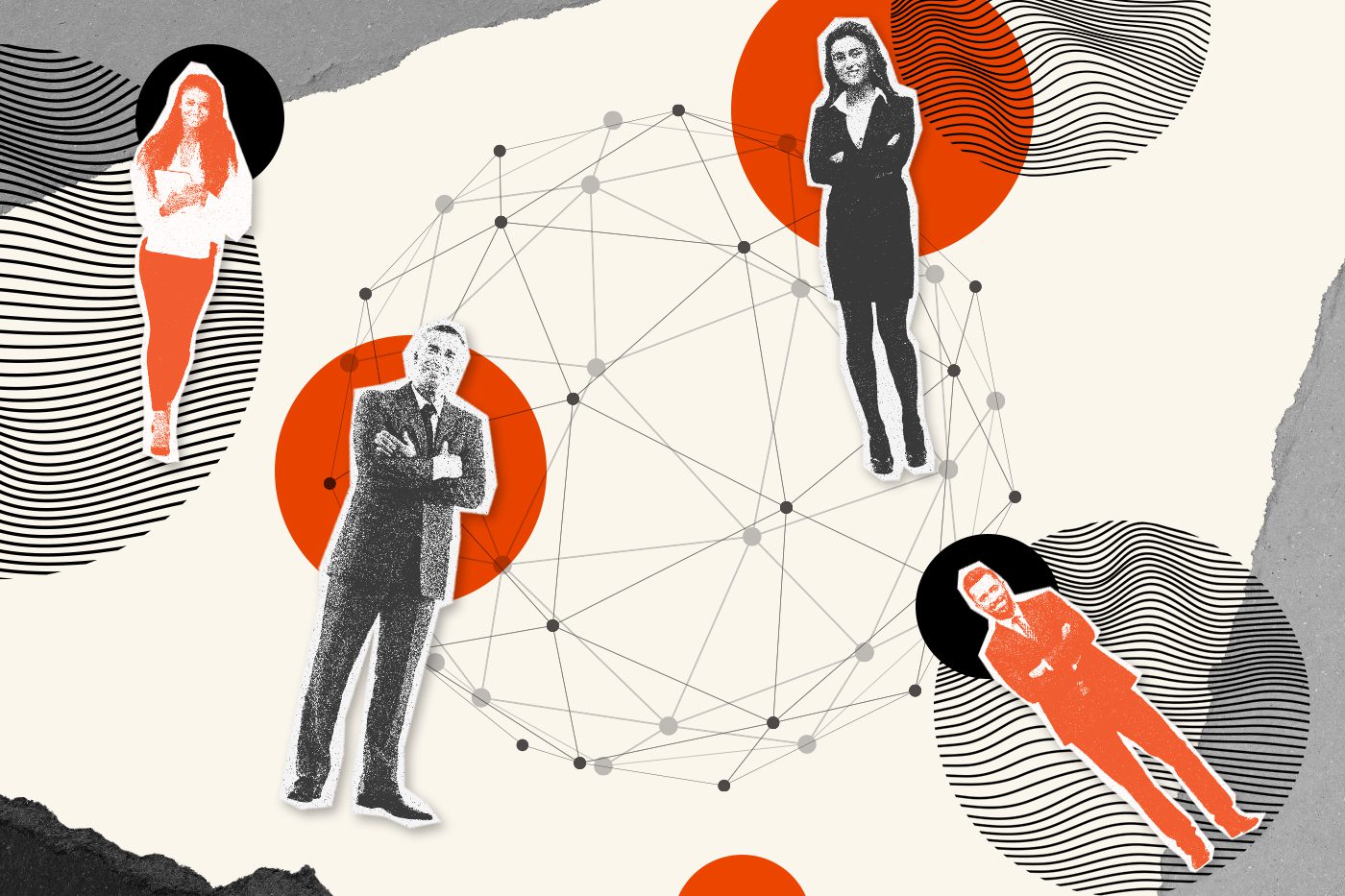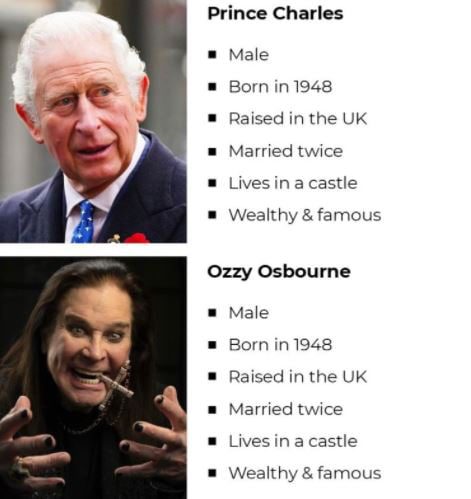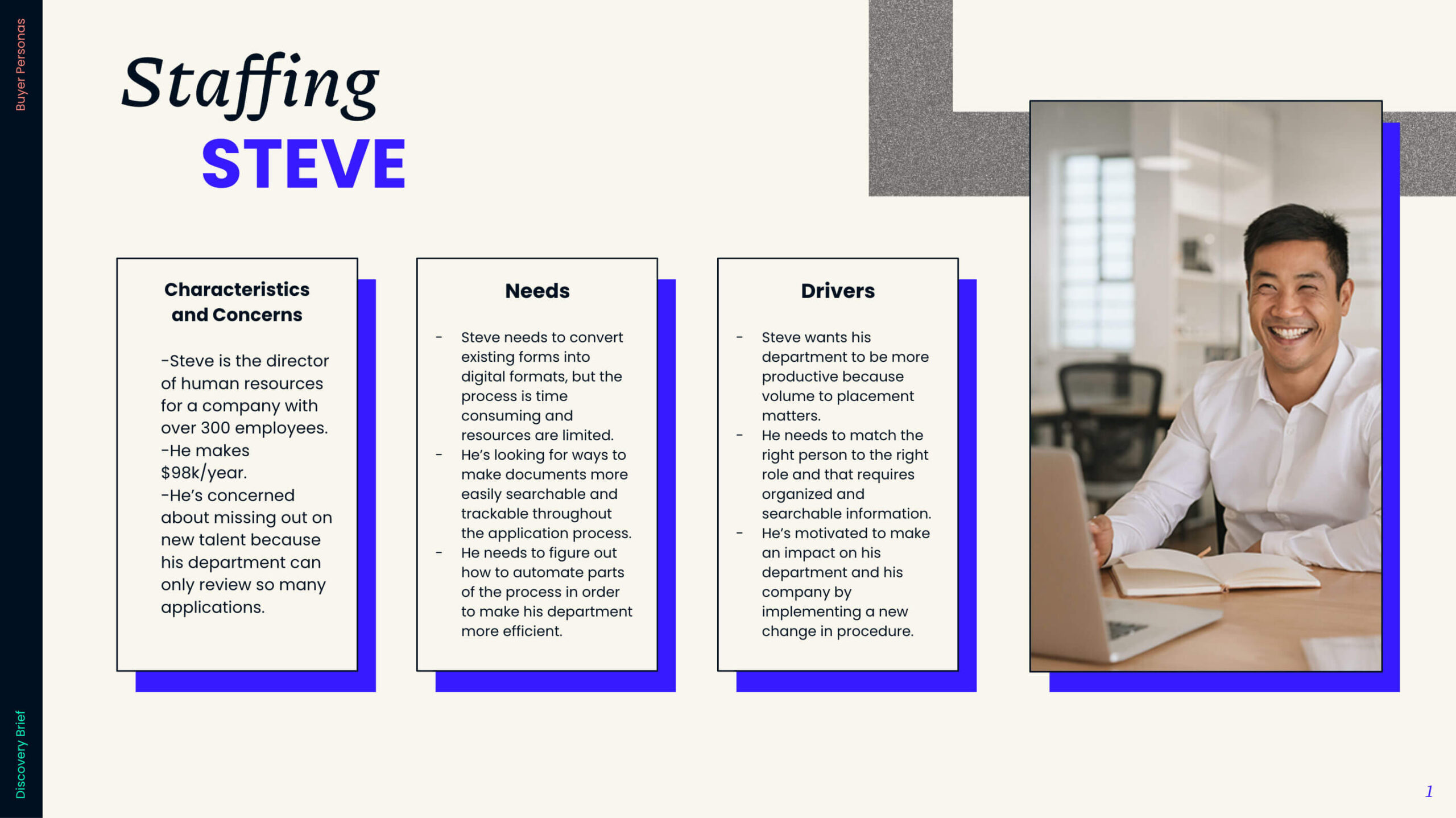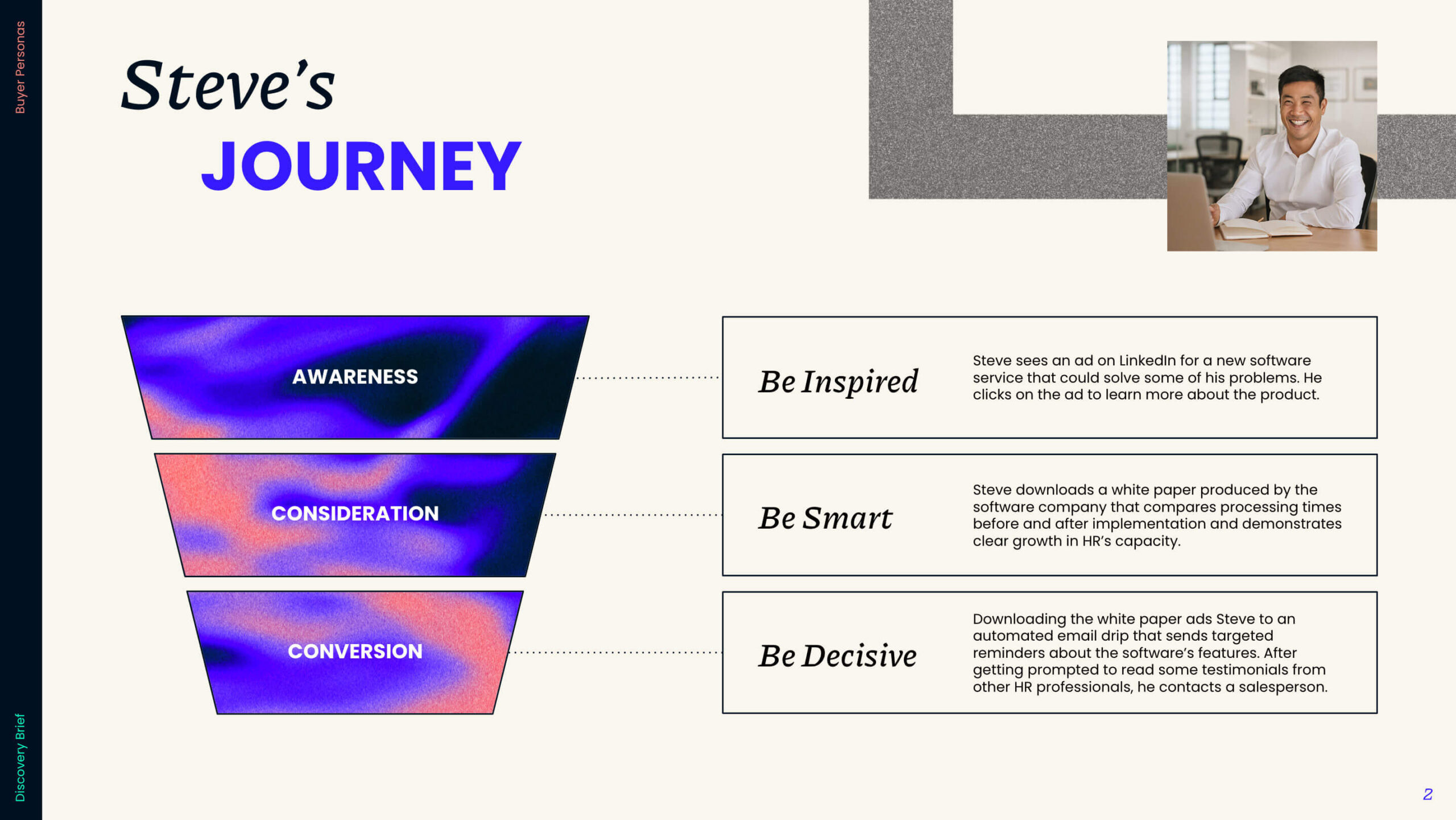5 Secrets of a Great B2B Buyer Persona
- What is the difference between B2B and B2C buyer persona?
- What is a B2B end user?
- What are the essential elements of a B2B buyer persona?
- How many buyer personas do I need?
- 5 Secrets of the B2B Buyer Persona
- 1. Effective personas are based on hard numbers, not stereotypes.
- 2. Purchasing decisions have motivations.
- 3. If you talk to businesses, they'll tell you what they need.
- 4. A persona's features should interconnect.
- 5. Talk to somebody, not just anybody.
- Work with a team that understands B2B buyers
Everybody’s got a type. When it comes to target marketing, businesses are no different. If you’re looking to make a real connection with a potential B2B partner, you need to know what they’re all about — and speak to their unique interests.
The benefits are varied and many. Creating personas for your B2B marketing strategy can:
- Paint a picture of your customers — allowing for effective targeting
- See clearly who you should not be marketing to
- Help you create valuable content that solves real problems they face
- Observe how different personas interact with each other along the customer journey
- Guide decision-making in your marketing strategy and customer experience
So what’s the impact for your business? Well, now you can personalize your customer experience, create more successful marketing campaigns, develop new products and services, and create more valuable content that aligns with true customer needs. Which leads to the ultimate result: better performance — with increased sales and revenue to match.

What is the difference between B2B and B2C buyer persona?
When it comes to buyer personas, it’s easy to recognize that B2C personas focus on the needs of an individual person. Buyers are looking for solutions to their individual problems. Emotional connections are crucial to building these relationships.
It’s easy to forget that B2B buyers are people, too, who also make decisions with similar emotional factors, and with whom you’ll need to develop authentic relationships. Understanding the business and human problems facing a B2B buyer is crucial to finding a real connection.
When it comes to B2B, buyers want more B2C-like experiences than conventional wisdom advises. For example, a recent survey from Salesforce found that 72% of B2B buyers wanted more personalized engagement. While you’ll hear plenty of talk about making rational or logical connections with these potential partners, remember that you’re still talking to a person.
Hopefully, they’ll love what you do and talk about your magnificent brand with the rest of their team. If your persona connects strongly with an individual person-of-influence, they become an extension of your marketing team.
What is a B2B end user?
An end-user is the one who is going to actively use your product or service. That’s the hard-working person that will actually use your software or service, but they might not actually be the buyer. That’s where B2B marketing can get tricky: there are multiple people with varying needs that you’ll need to address with your marketing.
While some may have no input whatsoever, many end users will play a crucial but hidden role in a purchase. The person placing an order might well have used recommendations from the end users to guide their decisions. That’s why it’s crucial to keep that end-user in mind and get them exactly what they need right when they need it.
What are the essential elements of a B2B buyer persona?
There are as many personalities in the world as there are people, and it’s not enough to rely on surface-level demographic assumptions to define your personas anymore.

We can’t be certain, but we can definitely assume that King Charles and Ozzy Osbourne – though quite similar in demographic signifiers – are fairly different in how they make purchase decisions.
To go a little deeper and really focus your marketing, consider the psychographic and behavioral characteristics of your buyers:
- Where they research products and services
- The level of political influence they have (or need) to make decisions
- How much time they’ll spend considering your product among competitors
- What drives their decision making (speed, price, etc.)
- Who in their circle might need input or have a stake in the decision
- What challenges they face in their day-to-day work life
- Where they find joy or entertainment
How many buyer personas do I need?
While there’s no magic number, we commonly see between 3 and 8 personas for B2B marketing purposes. At a minimum, we recommend at least two. Ultimately, use as many personas as you need to represent every influencer involved in the purchase decision for your product or service.
Too many personas will divide not only your attention, but your customers’ as well. If any two personas are very similar in their customer behaviors, goals, or pain points, consider merging them into one that is comprehensive and effective.
Remember: when you sell to everyone, you’re selling to no one. So get specific and really think about the ideal customer profiles – not just every potential customer that exists.
5 Secrets of the B2B Buyer Persona
There are plenty of step-by-step guides on how to develop an effective buyer persona. But there are a handful of elements that you want to keep in the front of your mind while carrying out your plan.
1. Effective personas are based on hard numbers, not stereotypes.
Stick to the facts and you’ll be golden — and there are several great places to look. Since your persona is an example of your ideal customer, you need to know precisely who that is. In the case of B2B, your ideal customer is a certain type of business or organization. But remember: you’ve speaking to the key participants in the buying process — not The Company.
That means research. You can develop personas based on:
- Interviews with current or previous clients
- Focus groups
- Web surveys
- Quantitative studies
- Social media listening
- Online research communities
- Lead gen forms
- Demographics in your CRM database
- SEO and keyword performance
2. Purchasing decisions have motivations.
Forget what you need from a customer. Focus on what they need from you. What’s motivating them to research products in the first place? When they set out on a path to purchase, you want to be there waiting for them when they arrive.
Search queries can quickly reveal whether your content is likely to be seen — and can highlight missed opportunities. You can even extrapolate the other data you’ve collected to make some predictions about future motivations.
3. If you talk to businesses, they’ll tell you what they need.
Meet Staffing Steve. You can probably tell from the level of detail and interconnection that the marketing client actually talked to this guy (and did a lot of research).

Steve happened to want searchable, trackable forms plus an automated and digital process. Luckily for this B2B SaaS client, that’s precisely what they were in business for. Having some extra details (his staff are doing this manually, and slowly) gives more insight into how to speak to Steve about healing his pain points.
Once you understand your target customer’s concerns, their needs, and their drivers, you can understand what motivates them in a nuanced way and reach them where they live online. Properly placed and targeted marketing will lead them through the customer journey, addressing their pain points at every step.

4. A persona’s features should interconnect.
Every persona should be carefully developed, but don’t include things that aren’t useful. We develop personas for our own B2B clients all the time. They’re always useful tools, especially for companies that are new or looking to restructure and refresh.
Consider another buyer persona we put together for a B2B client, Mentor Marcia. The profile was simple, but highly specific (and therefore useful). All of the attributes tie together to create a focused portrait of a type of buyer the company could appeal to.
Mentor Marcia is a businesswoman in her 60s with an MBA — she’s bored with her work routine, so establishing a side hustle could be just the amp-up that she needs. She wants to give back and stay engaged with the local business community. In particular, she wants to support women entrepreneurs, so her side hustle could be a role that’s related to that. Her MBA and life experience give her plenty of options and acumen.
Depending on what products and services you’re offering, Marcia might be the perfect business partner to pair with — especially if you work with startups and small business owners.
5. Talk to somebody, not just anybody.
There are lots of stakeholders within businesses. This often means getting multiple people on board before closing a deal. This is where specificity in your personas is crucial.
You might need a distinct persona for the executive, the accountant, the IT engineer, and the designer. These are your niches. They could have very different motivations and pain points — but their goals are probably aligned.
Ask yourself, for each persona: “What, exactly, does this person do for their organization?” You’ll want to determine their:
- Title
- Seniority
- Function
- Decision-Making Power
- Skill set
These get integrated into your other essential demographic elements to create the whole persona.
Work with a team that understands B2B buyers
In the marketing world, there’s no time to waste. You should work with skilled, experienced B2B professionals that can do the research, strategizing, and persona creation you need to speak directly to your target audience.
And that’s what Big Sea does. Our award-winning strategies are individualized and tailor-made for B2B, whether you’re working inbound or outbound. If you’re ready to find your perfect (customer) match, contact us today to schedule a consultation.

